Authentic Stollen (German Christmas Bread)
This post may contain affiliate links. See my disclosure policy.
German Stollen have been around for nearly 700 years and are prized throughout the world as one of the most famous and beloved of all Christmas pastries. Made with homemade candied orange peel and marzipan (both super easy to make) your search for the BEST authentic German Stollen recipe has ended. Flaky, moist, and divinely flavorful, these homemade German Christmas Stollen are INCREDIBLE!
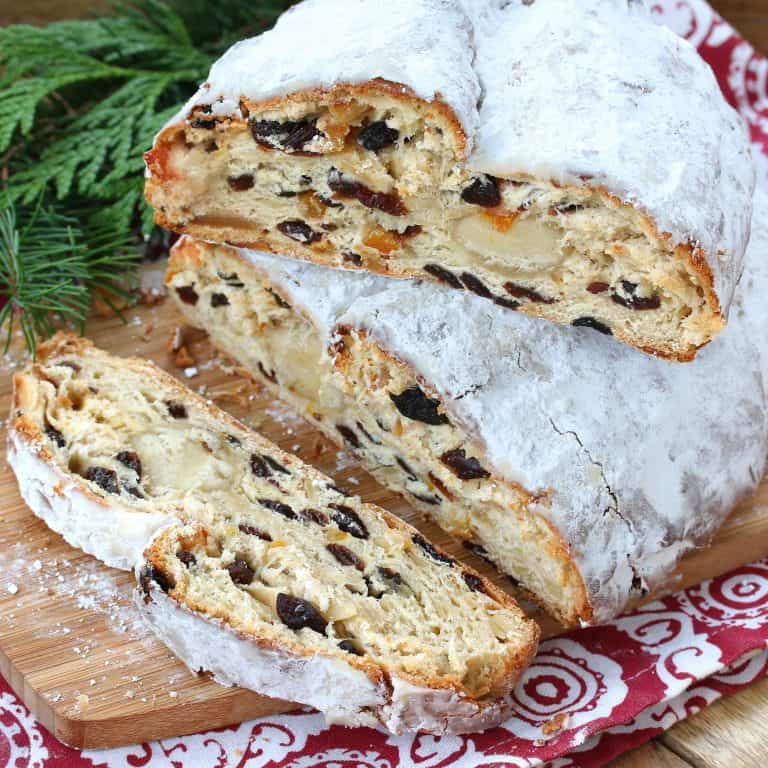
Sweet cakes and breads studded with candied fruits and nuts are hallmarks of Christmas baking in many areas of the world. Examples in the English speaking nations include fruit cake or Figgy Pudding, Scottish Dundee Cake, and then there is Panettone in Italy, keks in Poland, julekake in Norway, bolo-rei in Portugal, Hutzelbrot in Germany, and birnenbrot in Switzerland. But perhaps none are revered as highly throughout the world as German Stollen. I’m from southern Germany and celebrating the Christmas season without Stollen is simply unthinkable.
What is Stollen?
Christmas stollen, known in Germany as Christstollen or Weihnachtsstollen, is a yeasted fruit bread that is baked with dried fruits, candied citrus peel, nuts and spices. Stollen are baked free form into cake-like loaves that are folded in a sort of lopsided way that is characteristic of them. Stollen is sweet but it contains relatively little added sugar and instead derives its sweetness from the dried fruits and candied citrus peel. Stollen are famously dusted with a thick coat of powdered sugar, reminiscent of the snowy German landscape (like beautiful Ramsau by Berchtesgaden below), and baked with spices conveying the warmth of the Christmas season.

Where Did It Originate?
The first and most famous variety of stollen is the Dresdner Christstollen. Some historians date its concept back to 1329, and over the centuries the stollen was refined to become what it is today. And it has come a long way indeed because originally it was a bland and rather hard pastry as the use of butter and milk was forbidden during Lent by the Catholic church. Petitions were submitted to the pope, the first one in 1450, for permission to use butter for making the Stollen but it was denied. Fifty years and five popes later, Prince Ernst von Sachsen, at the request of the bakers of Dresden, petitioned the pope again to lift the butter ban. It was granted this time via the pope’s famous Butterbrief, “butter letter” – but only to members of the Prince’s household. A few select others were also granted permission but only on condition that they paid an annual sum of gold for the building of the Freiberg Minster.
The butter ban was once an for all lifted during the Protestant Reformation of the 16th century. From that point the stollen gradually developed into an enjoyable sweet bread incorporating additional ingredients and it become an important symbol of the region. King August II in 1730 commissioned the bakers of Dresden to bake a gigantic stollen in celebration of the strength of the Saxon military, an event to which he invited the dignitaries of Europe in the hope of building allies. The stollen weighed 1.8 tons (that’s 3600 pounds!), was 27 feet long and 18 feet wide and a special oven was designed and built just for this purpose. It took a convoy of eight horses to transport the stollen to the king’s table and a 26 pound and 5 1/4 foot-long knife was used to cut it.
Germany’s first Christmas market was held in Dresden in 1434. This market, the Dresdner Striezelmarkt, continues to be held every year. Also held annually on the Saturday prior to the 2nd Advent is the Dresdner Stollenfest featuring Germany’s largest Christstollen. So far 2013 holds the record for the largest Stollen weighing nearly 9400 pounds! Each year a horse-drawn carriage parades the giant stollen through the streets and on to the Christmas market. Per tradition, a replica of the original 5-foot long knife is used to slice the stollen. The mayor of the city tastes the first piece and the stollen is then cut into thousands of pieces that are sold with the proceeds going to charity.

The Symbolism Behind Stollen
The word “stollen” refers to a post or boundary stone for a city. It is also thought it could refer to the entrance of a mine shaft. Some historians believe that the stollen’s characteristic shape was molded after the shape of a mine tunnel, reflective of the silver and tin mining industries of the time. But there is also religious symbolism behind the stollen with the loaf, or bread, being symbolic of the body of Christ. Specifically, being dusted with powdered sugar, it is symbolic of the baby Jesus in swaddling clothes. Thus it is traditionally called Christstollen, or Christ Stollen.
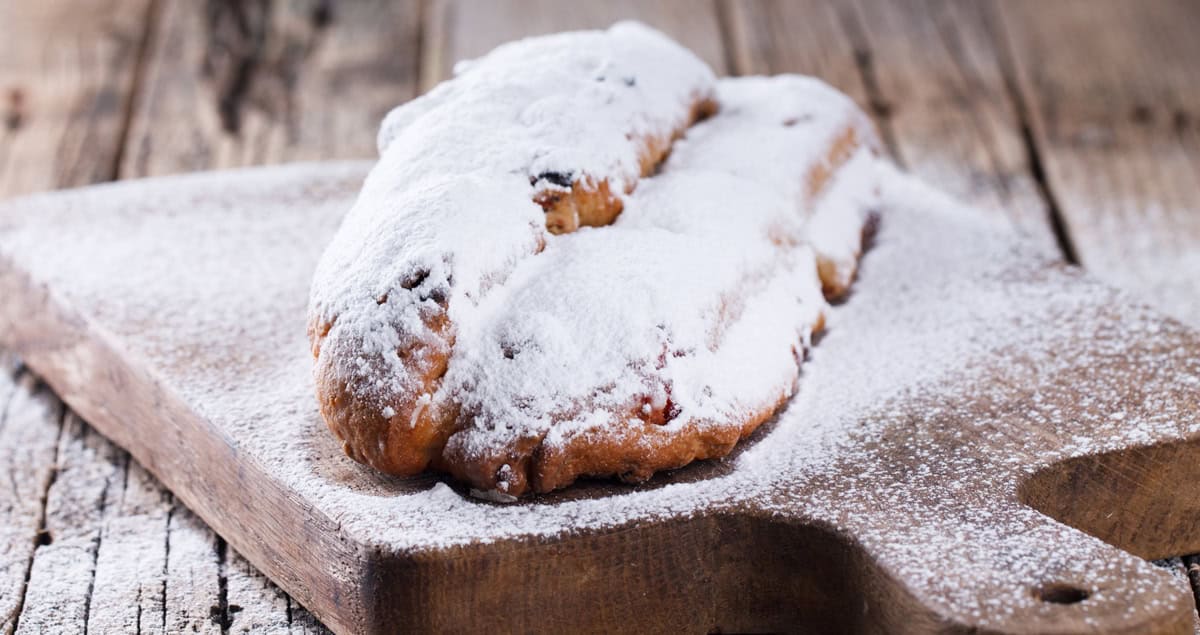
Stollen Variations
Other popular variations of Stollen include Mandelstollen (almond stollen), Mohnstollen (poppy seed stollen), Quarkstollen (made with quark), Nuss-Stollen (nut stollen), Butterstollen (high butter content), Dresdner Stollen and Marzipanstollen (marzipan stollen). Mohnstollen is another one of my favorites.
How to Make the BEST Stollen
For anyone who may be feeling a little intimidated at the thought of making Stollen, don’t be. If you can make a cake or a loaf of bread, you can make Stollen. But while it’s easy to make, it’s not quick to make. There’s a waiting game involved both during the baking process and the aging process. In the baking process the Stollen dough has to rise a couple of times just like in making yeast bread. Then it has to bake for a while. And then there’s the waiting process.
I’m sharing with you my recipe for Stollen which is thoroughly authentic in its method and ingredients. It features dried fruits, candied lemon peel, nuts and marzipan (which you can omit if you choose). I LOVE the addition of marzipan and it’s one of the most popular varieties of Stollen. Don’t worry about having to go out and buy marzipan, it is unbelievably quick and easy to make your own (seriously, it takes about 5 minutes). Check out my recipe for easy homemade Marzipan!
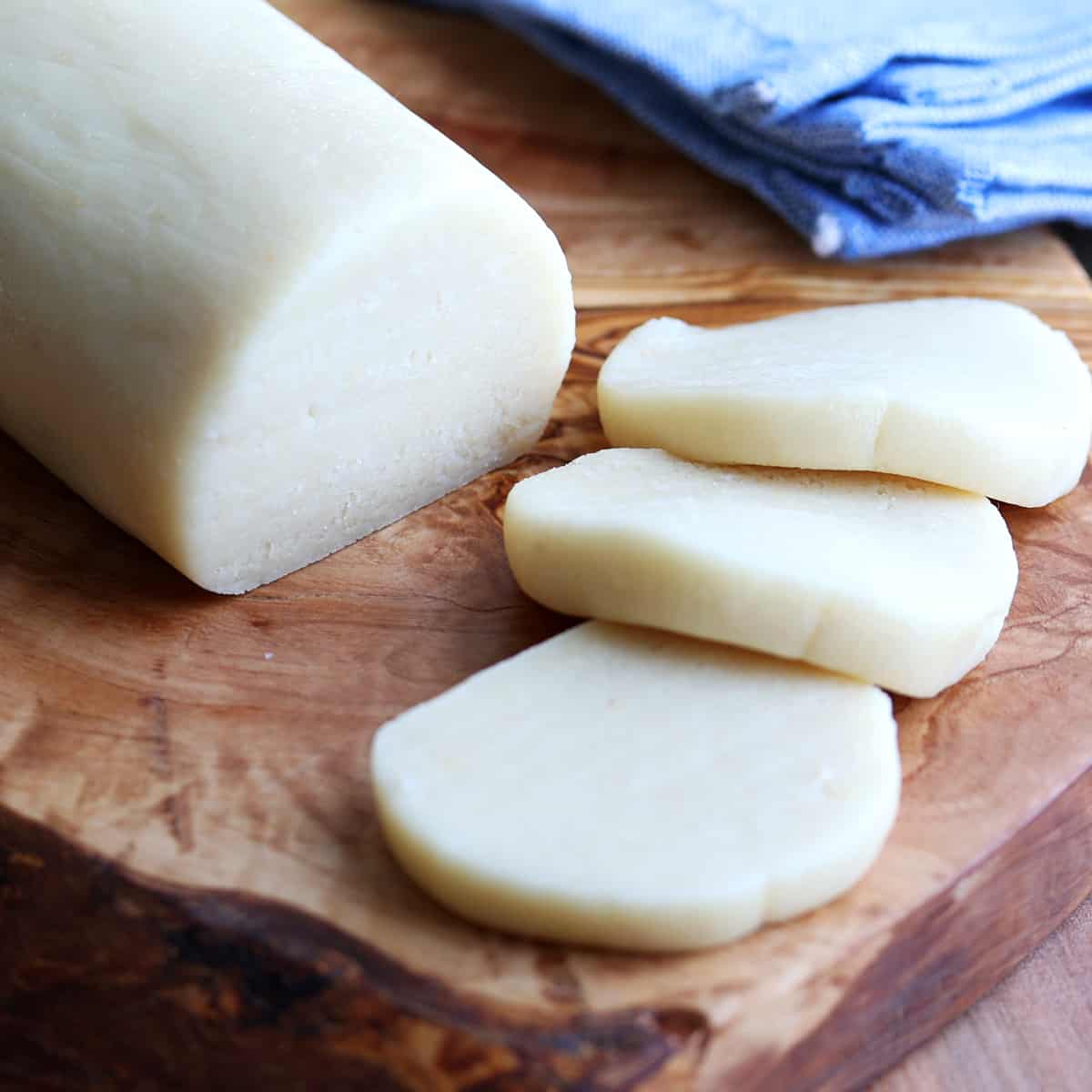
Candied Citrus Peel. Do you hate store-bought candied orange and lemon peel as much as I do? I have to tell you, I absolutely detest store-bought candied citrus peel. And most people I speak to feel the same. It has a bizarre chemical flavor no matter the brand. For that reason I’ve never been a fan of fruitcakes in general. BUT (and there’s a big but) using your own homemade candied citrus peel is a 100% deal changer.
While you can use store-bought candied citrus peel if you insist, I VERY, VERY STRONGLY recommend making your own. Please, trust me on this: Using homemade candied citrus peel is the difference between night and day when it comes to flavor! It is vastly superior in every way and will make your Stollen taste incredible! And the good news is it can be made far, far in advance. In fact, I freeze mine so it lasts basically forever and I take out what I need as needed. Check out my recipe for Candied Orange Peel!

Storage Tips
Typically the Stollen is tightly wrapped and kept in a cool place to age for 2-3 weeks before eating. This allows the liquid from the rum-soaked dried fruits to soak into the bread creating both flavor and moistness.
Fun trivia: Fruitcakes that contain a lot of alcohol can remain edible for years. Yes, years. For example, the Antarctic Heritage Trust discovered a 106-year-old fruitcake last year and after sampling it (the brave souls) they said it was not only in “excellent condition” for its age but was even “almost” edible! Another fruitcake baked in 1878 in Michigan was kept as a family heirloom and sampled for the first time in 2003 by Jay Leno on The Tonight Show. It’s amazing what an incredible preservative alcohol is. So in other words, as long as you keep your Stollen tightly wrapped and in a cool place, letting it age for 2 weeks is, like, nothing.
Does Stollen have to be aged? No! While letting Stollen age will allow the flavors to fully penetrate the bread, this Stollen is absolutely AMAZING straight out of the oven! So the question of whether to wait or not to wait I’ll leave up to you.
If you’ve never been a huge fan of store-bought Stollen you’re not alone. I’ve never cared for them either. But homemade…that’s an entirely different story. Just check out the hundreds of rave reviews below: Your search for the BEST Stollen recipe has ENDED.
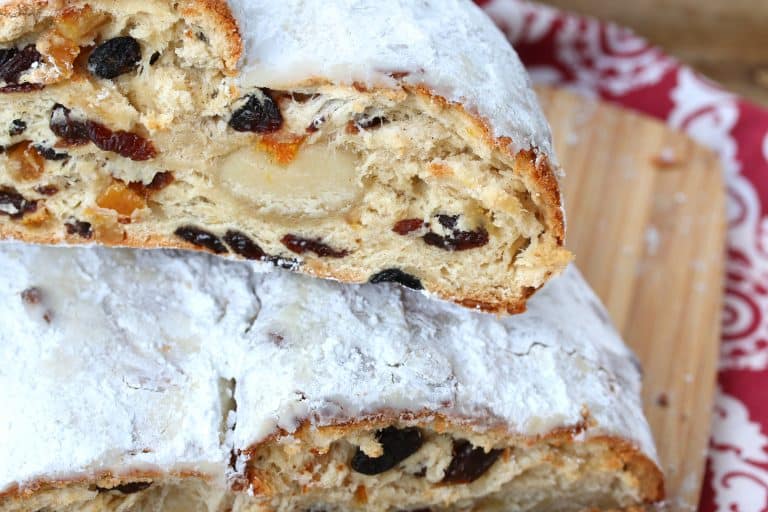
Authentic German Stollen Recipe
Let’s get started!
Place the raisins, candied citrus peel and almonds in a medium bowl and pour the rum over it. Stir to combine. Set aside and let the fruit mixture soak in the rum while the dough rises.
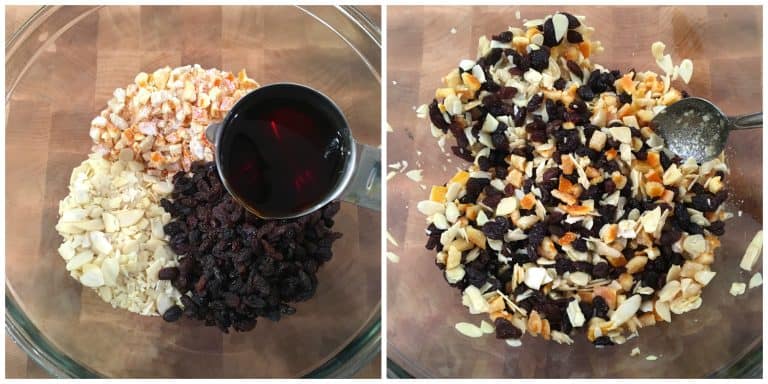
Stir the yeast and 2 tablespoons of the sugar into the lukewarm milk and let sit in a warm place for 10-15 minutes until very frothy.
Place the flour, remaining sugar, egg, egg yolks, butter, vanilla extract, lemon zest, salt, cardamom, mace and cinnamon in the bowl of a stand mixer fitted with a dough hook. Add the yeast/milk mixture.
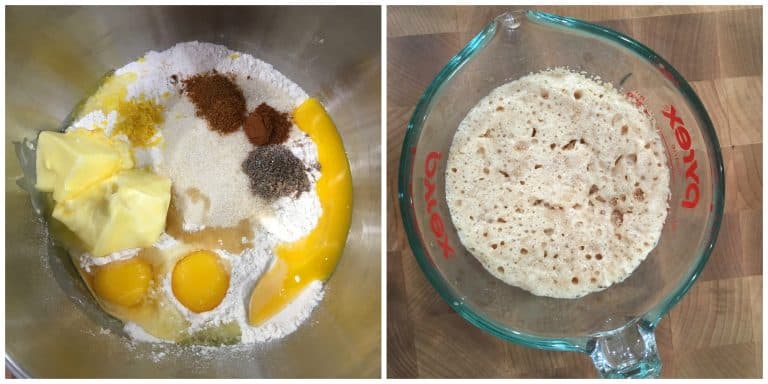
Use a spoon to stir the mixture until it comes together. Knead the dough on the bread setting and once the dough comes together continue to knead for 7 minutes.
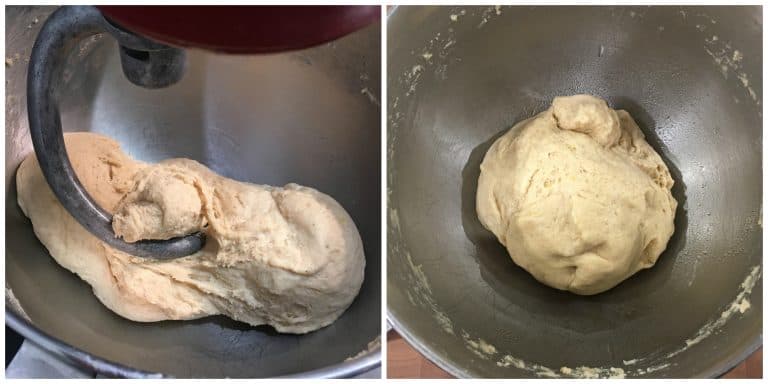
Remove the dough ball, lightly spray the bowl with a little oil, return the dough ball, cover loosely with plastic wrap and place it in a warm place or lightly warmed oven (just barely warm), to rise until nearly doubled in size, at least 1 hour.
Punch down the dough and add the soaked fruit/nut mixture to the dough (it should have absorbed all the rum by now but if there is excess liquid, pour it out before adding the mixture to the dough).
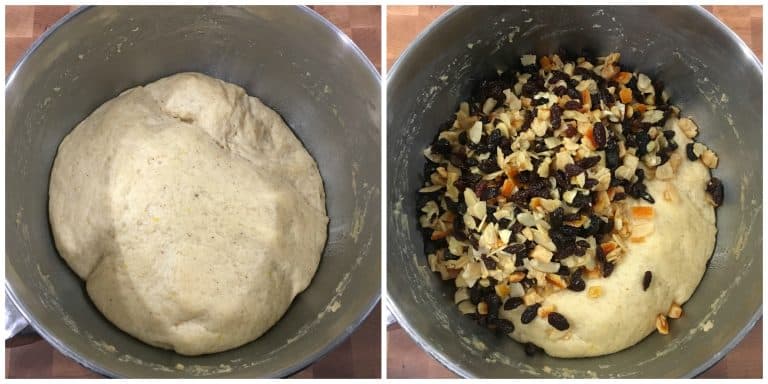
Using the dough hook, knead the fruit/nut mixture into the dough until combined. If the dough is too wet to handle, add a little bit of flour until the dough pulls away from the sides of the bowl. Note: I use my Kitchenaid stand mixer because it’s such a workhorse. You’ll also need a dough hook attachment. There are other pricier options on the market but I’ve been very happy with my Kitchenaid.
Turn the dough out onto a floured work surface.
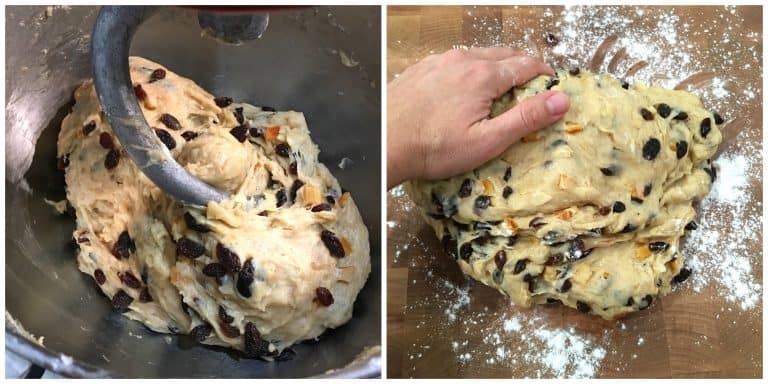
Cut the dough in two equal halves. Press or roll each piece into an oval to about 1 inch thickness. Roll each piece of marzipan into a log the length of the oval. Press the marzipan gently into the middle of the dough.
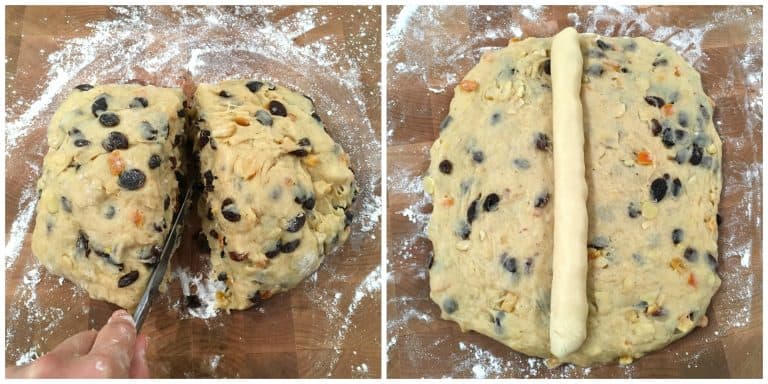
Fold the left side of the dough over to cover the marzipan, then fold right side over on top of the left side so that the edge of it sits just left of the middle of the stollen. In other words, don’t fold the right side all the way over to the left edge of the stollen.
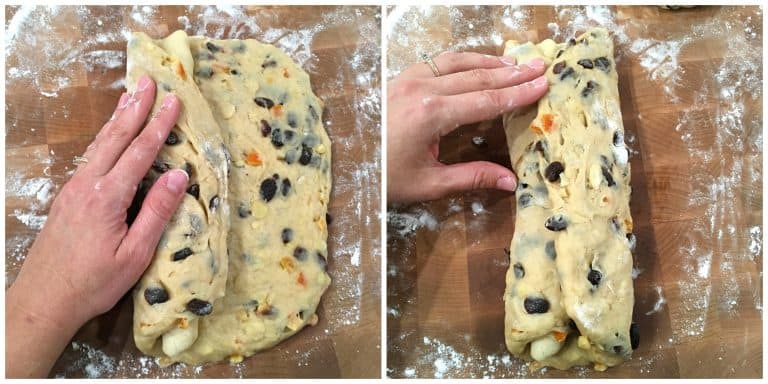
Pinch and tuck the top and bottom ends of the stollen to cover the marzipan.
Use the bottom edge of your hand to press down along the length of the stollen towards the right of the center to create a divot and characteristic hump.

Place the stollen on a lined baking sheet. Cover the stollen loosely with plastic wrap and let them rest in a warm place or lightly warmed oven for 40-60 minutes until puffy.
At this point you can pick off any raisins that are sticking out of the dough (they will burn during baking).

Towards the end of the last rise, preheat the oven to 350 degrees F and bake the stollen for 30-40 minutes or until golden. You can use an instant read thermometer (I love )to aim for an internal temperature of 190 degrees F.
Let them sit for 5 minutes, then use a toothpick to poke holes all over the stollen. This will allow the melted butter to seep in.
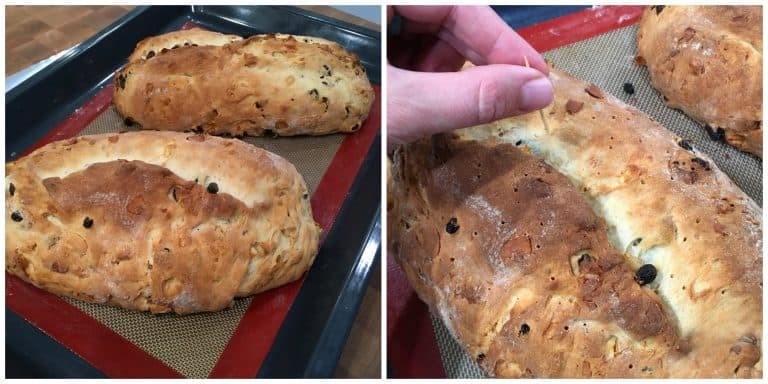
Generously brush the stollen with the melted butter while the stollen are still warm.
Immediately sprinkle with a generous amount of powdered sugar, rubbing it into the creases and down the sides. Let the stollen cool completely.
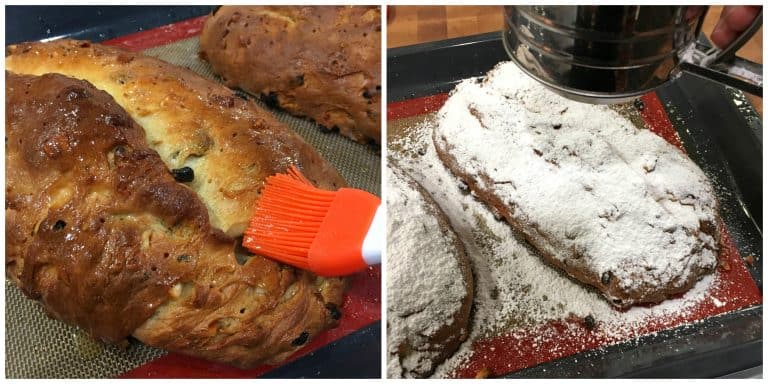
The stollen can be sliced and eaten now or wrapped tightly (I like to wrap in plastic wrap then foil) and left to “ripen” in a cool place for 2 weeks. The liquid from the dried fruits will further penetrate the dough for more flavor and moisture.
Stollen can also be frozen for longer storage.
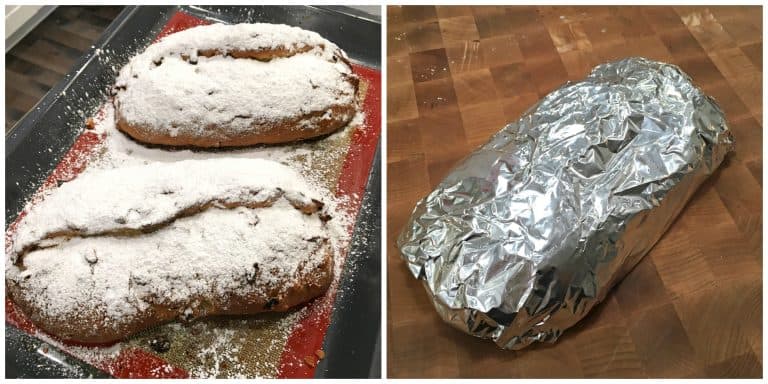
For eating, I like to warm the slices up for a few seconds in the microwave, it makes the crumb nice and soft.
Enjoy!
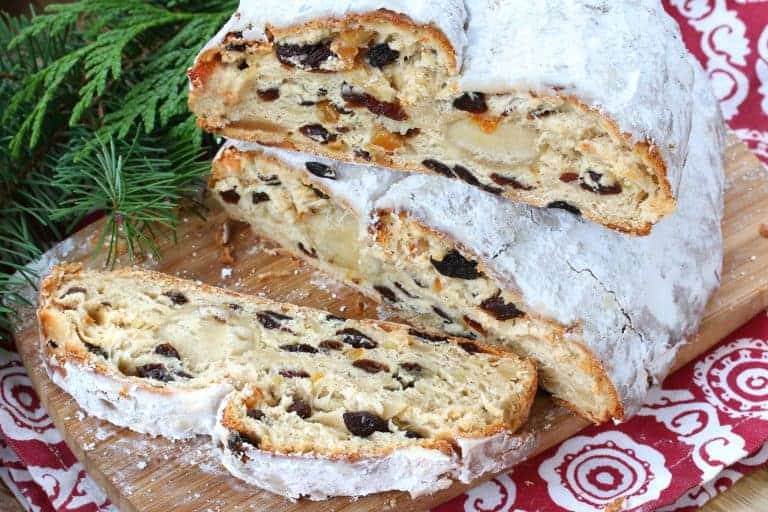
How to Make Gluten Free Stollen
I’m often asked “can I make this gluten free?” Yes, you can make gluten free stollen and I’ve had a several readers report back with success following the same method and simply substituting the flour 1:1 with GF flour. Follow all the same steps, including the rising time, though gluten free dough won’t rise to the same extent. It also won’t have the elasticity that regular dough has so be prepared to use a bench scraper as needed to help shape the dough. Be careful to drain the soaked fruits to eliminate as much excess liquid as possible and be prepared to add a little extra flour as needed until the dough is a workable consistency.
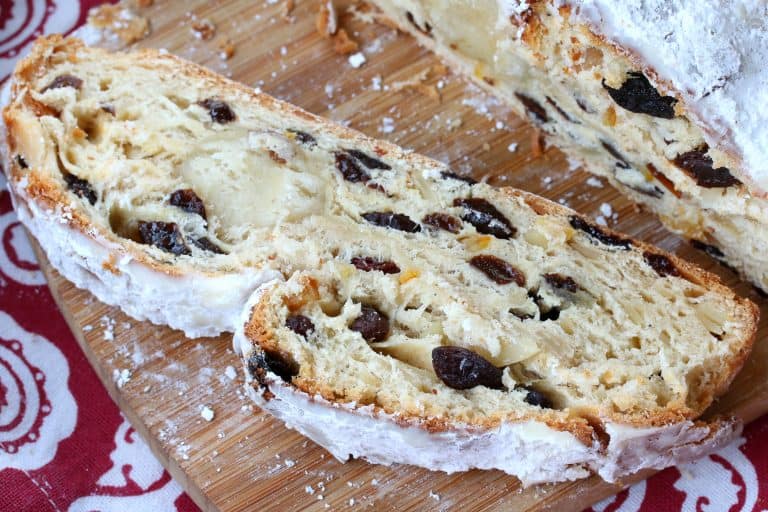
For more traditional German Christmas goodies try my:
- Pfeffernüsse
- Lebkuchen
- Springerle
- Gugelhupf
- Printen
- Speculoos
- Vanillekipferl
- Zimtsterne
- Kokosmakronen
- Magenbrot
- Bethmännchen
- Heidesand
- German Rum Balls
Save This Recipe
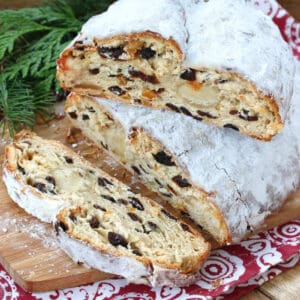
Authentic Stollen (German Christmas Bread)
Ingredients
- For the Dough:
- 1 cup lukewarm whole milk
- 3 teaspoons active dry yeast
- 1/2 cup granulated sugar
- 4 to 4 1/2 cups all-purpose flour plus more as needed NOTE: Amount will vary depending on how much liquid is retained in the soaked dried fruit. Be sure to drain any excess liquid. Add more flour as needed if dough is too wet. (Gluten free, substitute 1:1 GF flour.)
- 1 large egg
- 2 large egg yolks
- 3/4 cup unsalted butter (1 1/2 sticks) , at room temperature so it’s very soft
- 2 teaspoons quality pure vanilla extract
- zest of one lemon
- 1 teaspoon salt
- 3/4 teaspoon ground cardamom
- 3/4 teaspoon ground mace (recommended but can substitute nutmeg)
- 1/2 teaspoon ground cinnamon
- 8 ounces Homemade Marzipan/Almond Paste , divided in half (you can omit the marzipan if you prefer)
- or store-bought marzipan/almond paste
- For the Fruits & Nuts:
- 9 ounces raisins
- 3 ounces candied lemon peel , finely diced
- 3 ounces candied orange peel , finely diced
- Homemade Candied Citrus Peel Recipe (we VERY STRONGLY recommend using homemade, it makes ALL the difference!)
- 3 ounces blanched slivered or sliced almonds , finely chopped
- 1/3 cup quality dark rum
- For the Glaze & Dusting:
- 1 stick unsalted butter , melted
- powdered sugar for generous dusting
Instructions
- Place the raisins, candied citrus peel and almonds in a medium bowl and pour the rum over it. Stir to combine. Set aside and let the fruit mixture soak in the rum while the dough rises.
- Stir the yeast and 2 tablespoons of the sugar into the lukewarm milk and let sit in a warm place for 10-15 minutes until very frothy.
- Place the flour, remaining sugar, egg, egg yolks, butter, vanilla extract, lemon zest, salt, cardamom, mace and cinnamon in the bowl of a stand mixer fitted with a dough hook. Add the yeast/milk mixture. Use a spoon to stir the mixture until it comes together. Knead the dough on the bread setting for 7-8 minutes. Remove the dough ball, lightly spray the bowl with a little oil, return the dough ball, cover loosely with plastic wrap and place it in a warm place or lightly warmed oven (just barely warm), to rise until nearly doubled in size, at least 1 hour (likely closer to 2 hours depending on the temperature of the environment).
- Punch down the dough and add the soaked fruit/nut mixture to the dough (it should have absorbed all the rum by now but if there is excess liquid, pour it out before adding the mixture to the dough). Using the dough hook, knead the fruit/nut mixture into the dough until combined. If the dough is too wet to handle, add a little bit of flour until the dough pulls away from the sides of the bowl.
- Turn the dough out onto a floured work surface and cut it in two equal halves. Press or roll each piece into an oval to about 1 inch thickness. Roll each piece of marzipan into a log the length of the oval. Press the marzipan gently into the middle of the dough. Fold the left side of the dough over to cover the marzipan, then fold right side over on top of the left side so that the edge of it sits just left of the middle of the stollen (see pics). In other words, don’t fold the right side all the way over to the left edge of the stollen. Pinch and tuck the top and bottom ends of the stollen to cover the marzipan. Use the bottom edge of your hand to press down along the length of the stollen towards the right of the center to create a divot and characteristic hump (see pics). Place the stollen on a lined baking sheet. Cover the stollen loosely with plastic wrap and let them rest in a warm place or lightly warmed oven for 40-60 minutes until puffy. At that point you can pick off any raisins that are sticking out of the dough (they will burn during baking).
- Towards the end of the last rise, preheat the oven to 350 degrees F and bake the stollen for 30-40 minutes or until golden. You can use an instant read thermometer to aim for an internal temperature of 190 degrees F. Let the Stollen sit for 5 minutes, then use a toothpick to poke holes all over the stollen (this will allow the butter to seep in), then generously brush the stollen with the melted butter while the stollen are still warm. Immediately sprinkle with a generous amount of powdered sugar, rubbing it into the creases and down the sides. Let the stollen cool completely. You may want to give it another dusting of powdered sugar once cooled.
- The stollen can be sliced and eaten now or wrapped tightly (wrap in plastic wrap then foil) and left to "ripen" in a cool place for 2 weeks. The liquid from the dried fruits will further penetrate the dough for more flavor and moisture. Stollen can also be frozen for longer storage.
- Makes 2 large or 3 medium Stollen.For eating, I like to warm the slices up for a few seconds in the microwave, it makes the crumb nice and soft.
Nutrition
Originally published on The Daring Gourmet November 20, 2018



















If you wanted to use a little almond flour for the dough, what would the ratio be?
Thanks!
Hello Kimberly! I am excited to make this recipe for my knitting group’s holiday sweets sharing (instead of cookies!). I have a question. I don’t prefer very sweet things and wonder if I can spread the marzipan out a bit, rather than have it in a solid roll within the dough (to “spread out” the sweetness). Hope that question makes sense! Thanks!
Hi Cheri, you sure can. Instead of the the solid roll you can break the marzipan up into smaller clumps and mix it throughout the dough. What a special treat to bring to your knitting group – happy baking! :)
KImberly: Bin auch ein Schwab, von Sindelfingen bei Stuttgart. Hab schon seit 20 Jahren mehrere Dresdner Stollen bebackt und zu Freunden gegeben, aber schickte keine nach Deutschland – meine Verwannte wollten keinen Stollen von mir, scheinbar weil sie dachten als Amerikaner konnte ich diese nicht nach ihren Normen verbringen! Muss aber sagen dass fuer meine Mutter, sowie fuer alle andere Empfaenger, mein Stollen (beinahe gleiches Rezept als deines) war immer ein Hochpunkt der Weihnachtszeit. Es freut mich immer durch dein “Daring Gourmet” ein vertrautes und beliebtes Rezept zu finden. Viele Glueckwuensche fuer die Feiertage und im Neuen Jahr. John (Jochen) Hutzel
Haha! Es freut mich dass Sie Ihre Mutter überzeugen konntest dass einer “expat” immer noch backen kann! :) Bezüglich die andere Verwannte, mein tiefstes Beileid – they missed out! Vielen Dank für das Kompliment, John. Ich wünsche Ihnen und Ihre Familie ein wunderbares Weihnachtsfest und frohes Neues Jahr <3
What can I say, Kimberly? An incredibly delicious recipe! Made your marzipan also – with 20% less sugar – also amazing. I won’t be buying shop stollen ever again! Thank you very much.
Wonderful, Ben, thank you so much for the feedback! :)
Is it possible to make this without eggs? Would flax seed/water mixture or flax seed/applesauce mixture work, or is something else required.
Hi, I know that substitute is theoretically supposed to work but I haven’t it with this Stollen so I can’t say from personal experience how well it works. Perhaps one of our readers has and can chime in.
Hello,
In terms of the amount of butter to pour over at the end, how much in grams is a ‘stick’ of butter? In Australia we don’t have a standard amount you buy in.
Thank you for your time.
Hi Lily, a stick of butter equals 114 grams. Happy baking!
Hej
Thanks for the recipe and am going to try it, how can i replace rum? Thanks alot and a nice day.
Hi Hannah, you can fruit juice instead (eg, apple, orange, cherry, etc). Happy baking!
So cool
Hi, I wanted to thank you for this awesome recipe(s)! I looked at several recipes, because I wanted to modify it for making the dough in a bread machine. I cut the recipe in half, including the yeast (made 1/2 in each of 2 bread machines). I also used bread flour (higher protein) instead of Enriched Flour, because I knew the bread machine was going to force me to do a 3rd proofing (2 in the machine & the 3rd after I kneading in the fruit). I use store bought candied fruit, but re-soaked it in rum for 2 days (using 15oz combination of candied fruit & raisins & 3 oz of chopped, slivered almonds) I made my own marzipan using your recipe. I had trouble getting the 3rd rise, so I used the oven method suggested: Setting it to lowest setting (170 F), turning it off, putting the bread in, which dropped it to the ideal temp of 70-85 F; closed the door, and left it for 1 hour. Then removed it to preheat at baking temp, and while the recipe says 30-40 minutes, my 1st loaf was dark at 30 min; and I pulled my 2nd loaf out at 25 minutes; both showing an internal temp of 190 F. I also poked holes on the bottom of the loaves & drenched with butter & powdered sugar; not just on top (the recipe didn’t specify that). Like I said, they turned out perfectly; very moist, which my Grandma’s was always dry, lol. I think “BUTTER” is the key (I didn’t skimp), hehe. Next time, besides wanting to make my own candied fruit/peels, I might used the Enriched Flour, and remove from the machines prior to the 1st proofing, and do all the proofing in my kitchen/oven method. Everybody loved the bread & there were no complaints. I just would’ve liked a little better rise, and I know that 3rd rise, was to blame…that, or I should’ve also added a little more yeast. Thank you again, your recipe is truly authentic, and the best I’ve seen!
That’s fantastic, Keem, I’m thrilled that you enjoyed it and thank you for providing that info on using a bread machine!
Depending on where you are will depend on how much flour you will need. It varies based on altitude and weather.
I made it and it was great. I have a son who hates raisins what other dried fruit would work as well? I want to give them as presents next year.
Thank you, Linda! Dried cranberries or dried cherries also work well.
You might try currants. They are berries not grapes and smaller than raisins. Dried cranberries might work. You could try chopped figs or dates. In a mix of fruits, a few prunes might work. Also some candied cherries. Not maraschinos. Or dried cherries if you can find ’em.
Hi Cath, I went several years thinking currants were berries too because, after all, red currants and black currants ARE berries. But then later learned that the things known as “dried currants” aren’t actually currants are at all, they are something called “zante currants” which are small raisins. Dried currants are widely used in British baking (Eccles cakes, spotted dick, etc) but they’re not actually currants, they’re raisins. It’s not very logical, but I’m not the one who named them, lol! :)
Some speculation that the word currant, when referring to grape raisins, comes from the place in Greece where they are grown, aka Corinth.
That makes a lot of sense, Casey.
(Zante) currants are raisins (tiny dried grapes).
Red, white, and black currants are a different fruit. Skeptical if they can be purchased in a dried form. Regardless, taste is completely different.
Dried cranberries, cherries, or goji berries would be better substitutes.
i made it with dried blueberrys and dried strawberry and preserved cherries greek stores have alot of preserved in thick syrup different fruits like cherries and the bulk stores have dried blueberries and other fruits like rassberries and strawberries
The measurements for the nuts and the candied peels are in ounces- weight ( using a scale) ? or volume using a measuring cup ? ?
Hi Peter, those are all measurements of weight.
One cup is not a weight measurement, it is a volume measurement. One cup flour is not the same as one cup fluid so being consistent with your measurements would be very helpful.
Hi Judith, these are US Customary measurements. If you’d like the measurements by weight simply click on “Metric” to the right of the list of ingredients.
Thanks so much, that’s helpful! I don’t have a “feel” for dough (practice!) so constantly question what’s right. I used the metric weight, but still had to add more. Thanks again and happy holidays!
This recipe is amazing, I’ve made it several years now and it’s a great gift especially for my European friends. One thing I still don’t quite know is how wet the dough should be. I definitely have to add more flour to even get anything not totally gloppy, but it should still be pretty sticky? It’s always come out fine, but it would need helpful to know the ideal dough consistency. I’m not sure I’m adding too little or too much flour. Thanks! It’s always a big hit.
Thank you so much, Ryan! The dough will remain tacky because of the dried fruits but when you turn it out onto a floured work surface it should be easy to work with. Are you using the cup or metric measurements?
I’m not Ryan, but I used the metric and the dough, even prior to adding the fruit was a gloopy mess and completely unworkable. I had to add in another 1/2 cup or so of flour to get something workable and I’m very used to high hydration doughs.
Was the original recipe developed in cups and auto translated to grams?
Hi, yes that’s right, it was developed in cups and the software converts it to grams. Reputable sources can’t agree on a “standard” conversion of a cup of flour to grams and they give a range of anything from 120g to 138g. But 520 grams flour is well within a “safe” limit for creating a result that shouldn’t remotely be too wet. I noticed that the metric conversion for the milk was 250ml and some sources say 236ml so I went ahead and manually adjusted that, but that is so minimal that it wouldn’t have much impact. In any case, I’ve had HUNDREDS of readers use the metric with nothing but success so that makes it especially perplexing getting feedback about the dough being completely gloopy even before the addition of the fruits. You sound like an experienced baker but it just isn’t logistically possible for a ratio of 520g flour to 250mL liquid plus an egg and two yolks to result in a completely unworkable wet mess. Most bread recipes have a considerably higher ratio of liquid to flour.
Hi Kimberly
Let me start by saying that the stollen were delicious even with the issue I encountered.
I made these last year and I had the same problem as RyanM and “Notryan” and my dough was very loose and unworkable before even adding the soaked fruit.
I used weights all the way through and had to add 160g flour to transform it into a workable dough.
What’s puzzling me is that you had hundreds of comments and none of them had this problem. Also the amounts of milk, eggs and butter are in line with brioche bread recipes I made before without issues!
So it must be something on my side of things.
I made notes for this year’s stollen to:
– make double sure I weigh everything correctly
– try a different brand of plain flour or use bread flour
– knead the dough to develop enough gluten before gradually adding the butter
Any other suggestions would be gratefully received.
This was my first time making stollen. Is it supposed to be dry? Was I wrong to expect a more moist crumb? I pulled mine from the oven before it reached an internal temperature of 190°F. My baker’s instinct told me it looked done well before that actually. I was mindful not to add any extra flour when forming the loaf. In fact, I added a lot of extra rum to my fruit mixture since my raisins were quite old. In addition to all of that, I aged it for 14 days too. So I was quite disappointed that it still turned out to be that dry. Or is that just how stollen is supposed to be? I’m curious whether the moisture would improve if the marzipan was distributed more evenly throughout the loaf rather than just a concentrated hunk. I would love to know your thoughts!
Hi Cheryl, yes, Stollen is supposed to be dry. Traditionally it’s eaten with a hot beverage. Keep in mind also that Stollen is technically a yeast bread, not a cake.